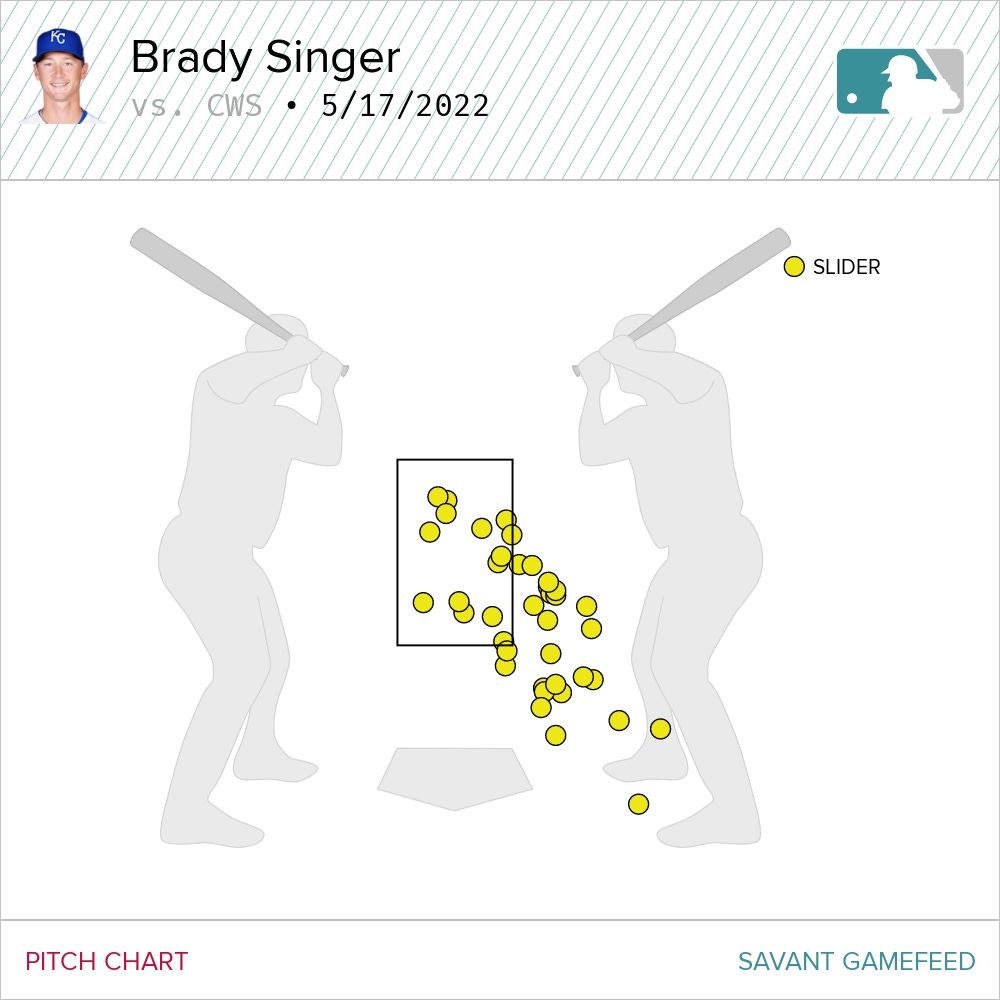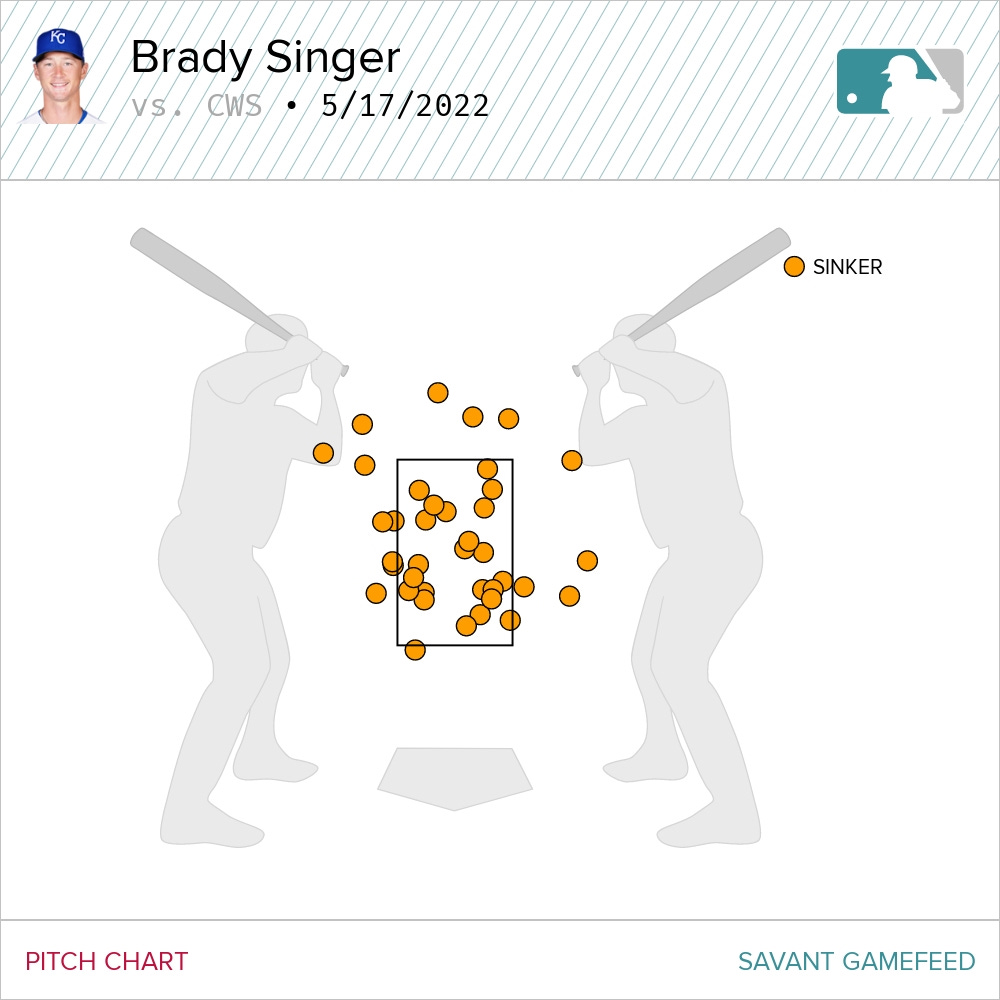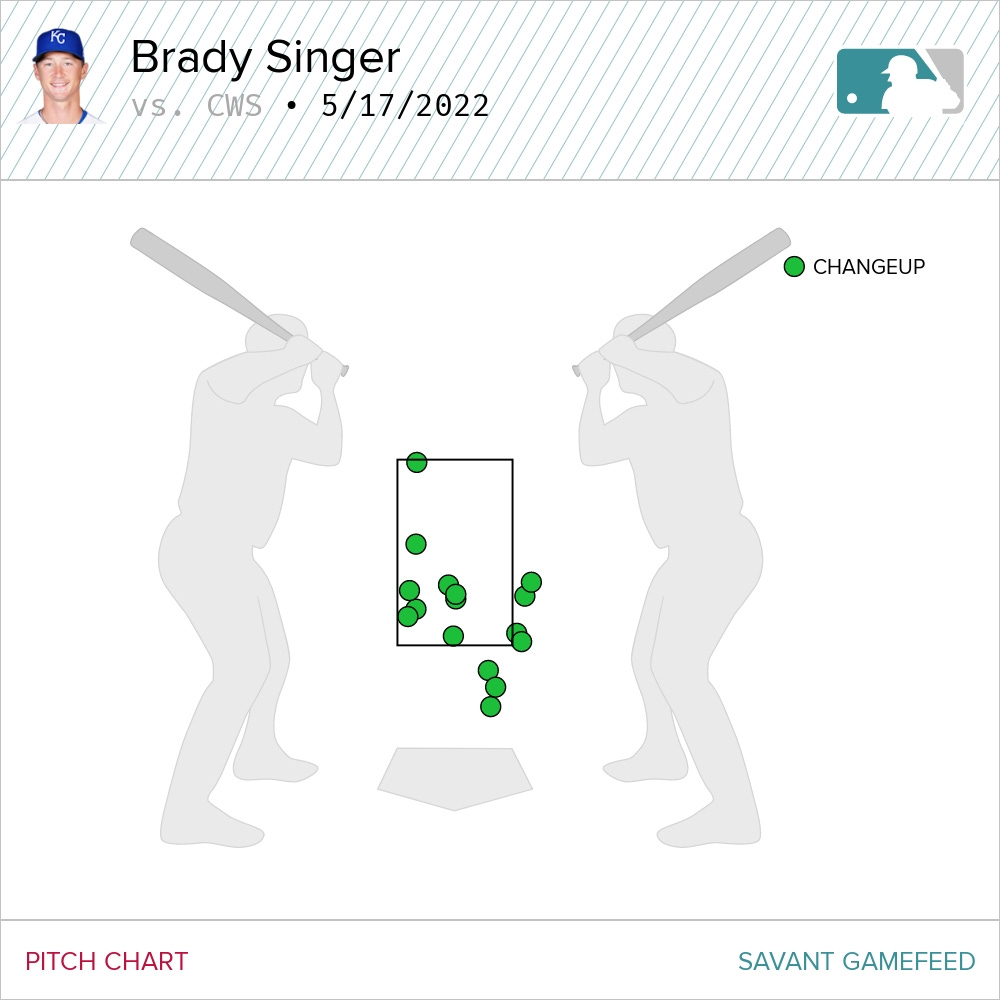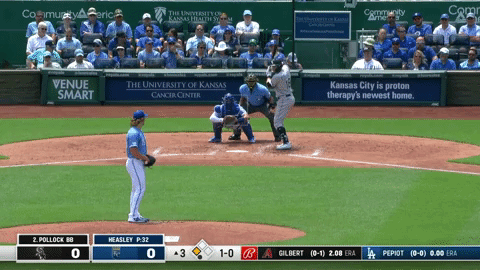Doing the Splits
Brady Singer was bonkers good. The Royals offense was not. But they got one at least.
Baseball is a game of sequencing. If you get three hits and then hit into a double play, you likely at least scored a run, but if you get a hit, then hit into a double play and then two hits, there’s a pretty good chance you don’t score at all. If you think back to the last two games of the homestand ahead of the long road trip, the Royals won one game 7-1 on the backs of a lot of the young players doing quite well. And then they lost the next game 10-0 and had to sit with that for three days off. Nothing would have been any different, but it would have been a lot easier to sit through no baseball if those games were flipped.
But finally, the Royals had the sequence right. If you’re going to split a doubleheader, win game two so that’s the last thing you think about before you go to bed. And if you’re going to win that game with one of your most polarizing pitchers on the mound, it’s pretty fun when he goes out there and throws arguably the second best game of his career.
So let’s go out of order because the fun was in game two when Brady Singer got the start after he spent 19 days in AAA building his pitch count back up to re-enter the rotation. In those three games, he threw changeups and reports were pretty good on them. I made a point on Twitter that his changeup didn’t need to be good. It needed to be there. And what I’d heard was that it was even better than there, even if it wasn’t exactly good just yet. So I was a little nervous, but also excited to see if he looked any different.
The verdict? Oh yeah, he did.
And it started immediately. He was admittedly facing the White Sox “B” lineup, but it was still full of solid hitters. He struck out the first batter he faced that included a swinging strike on his slider and a called strike three with his sinker. Both would be recurring themes. He did give up two two-out singles, but he came back and got the third out with no issue. The next runner he allowed came in the top of the fifth inning where he ran into some trouble again, but came out of it unscathed.
The end result was seven shutout innings where he struck out a career-high nine batters and didn’t walk anyone. His game score of 78 was the second-highest of his career, but I think you could argue he looked even better than his best start when he took a no-hitter deep into the game against Cleveland in 2020.
The destination was great, but the journey was an absolute masterpiece to watch. In the end, he threw 93 pitches with 70 strikes. Thanks to a question from @snakecooney on Twitter, I looked up the last time a Royals pitcher threw fewer than 100 pitches with 70 or more strikes and it was actually Brad Keller on August 4, 2019 when he threw 72 strikes out of 98 pitches. Singer’s outing was just the 47th time in franchise history a Royals pitcher has done that. In fact, Singer’s percentage of strikes was the 13th-highest in team history in a game where the pitcher threw at least 80 pitches.
What gets me so excited is that everything was working in its own way. His slider was just ridiculous. He threw 39 and got the White Sox to swing at 30 of them. They flat out missed 16 and fouled off seven more. They ended up with four hits in 19 at bats off the slider with eight of his nine strikeouts coming on the pitch. I don’t think I can overstate just how good it was.
He missed in the middle a couple of times, but even most of the pitches in the middle didn’t get hit. Where he got into trouble was actually on the slider that stayed up even though it was on the outer edge of the plate to a couple of batters. But otherwise, it was outstanding. The 53.3 percent whiff rate was the third-highest of his career with the slider.
One of the most interesting aspects of Singer’s game is how many called strikes he gets with his sinker, and that was absolutely on display in this one. He threw 38 sinkers and had 13 called strikes. He only had the one whiff on it, but it wasn’t hit hard when it was hit and the White Sox fouled off seven of them. Yes, I would love to see more swing and miss on that pitch, but when you’re getting that many hitters fooled to take them, something is working right. When he’s been bad, he’s had a tough time moving the sinker around the zone. He did not have that issue last night.
And then there’s that changeup. It’s the pitch we’ve all been wanting to see from Singer forever. It’s the pitch he’s waved off and laughed about not throwing. And it’s the pitch that has the most excited for him moving forward. As I said, it wasn’t great. It may not have even been especially good, but it was absolutely enough. He threw 16 of them, more than in any other game. That was 17.2 percent of his pitches, which is higher than in any other game. And the White Sox barely touched it. They swung at two of the 16 and took eight more for strikes. Remember when I told you that he had eight strikeouts on his slider, but had nine total. Oh yes, that’s right. The last one was on the changeup.
There are three on this chart that I think he’ll want back, but I love how he’s staying on the edges with it. And just to paint the full picture, here’s where he lived all night.
Notice the white spot directly in the middle? Yeah, I love that. The changeup is maybe a little firmer than I’d like to see. If he could back off the velocity to be even closer to his slider, I think you could see it make the slider look even better, but it was probably close enough in this start, averaging 88 MPH compared to 86.2 MPH for the slider. I’m curious to see if the next opponent, whether it’s the Twins or the Diamondbacks, is quite so patient as far as taking that pitch, especially when he misses in the middle with it, but I have to say that I’m impressed.
It isn’t lost on me that Singer went to AAA and did what the Royals had been wanting him to do for two years in the span of three starts, but that’s a complaint for another day while we enjoy this performance.
And of course, we wouldn’t be quite so happy about it if the offense didn’t chip in the little that it did. I’ll get to the first game in a minute, but you know about the issues with runners in scoring position. They didn’t get much better in this one, but they got enough better when Michael A. Taylor scored Emmanuel Rivera with a double in the second.
But the offensive highlight came when MJ Melendez did his thing for the first time.
He didn’t even seem to get it all and it flew. With Salvador Perez going on the IL in between games with a thumb sprain, we’re finally going to be seeing a lot of Melendez, who became the first Royals catcher in more than 25 years (Henry Mercedes) to catch both games of a doubleheader. The Royals should have been playing him every single day anyway, but now it looks like he’ll be the team’s starting catcher (with days off, of course). He’s looked absolutely fantastic behind the plate in the last couple after looking shaky to start his big league career.
This is a huge opportunity for the Royals. Maybe they determine that his defense gives them more than Perez does. Or maybe they determine it’s enough to make the arrangement more of a timeshare moving forward. That can only benefit Perez who hits so much better when he gets time off from behind the plate. Either way I’m excited to see it.
Oh (yes, I’m stalling), I can’t move on from this game without talking about two things from after Singer left. First was Andrew Benintendi’s throw and Melendez’s tag to keep the Royals in the lead in the eighth.
The throw was generally on line, though a touch short. Melendez made a phenomenal play to keep that ball in his glove and save Collin Snider’s bacon. This is a very different story if the throw is up the line or Melendez can’t hang on.
And then in the ninth, Josh Staumont looked as good as he’s looked in awhile. He was touching 99 on the gun, topping out at 99.4 actually, and throwing strikes. It’s been a bit of a struggle for him lately, but he looked fantastic in getting the White Sox 1-2-3 in the ninth on 16 pitches to secure the 13th win of the season.
Okay fine, let’s talk about the first game.
Game one was a game of missed opportunities, which a team like the Royals can’t afford to do very often. One of the things that Dayton Moore said the other day that I actually agreed with was the fact that the Royals had to cut down on their strikeouts in situations where a strikeout is among the worst things you can do. That means with runners in scoring position and specifically with a runner on third and less than two outs. On Monday night, the Royals didn’t have many chances. Their first runner in scoring position came in the sixth and then they had some runners out there in the eighth but scored them.
But yesterday, they were in business almost immediately. Whit Merrifield started things off with another double, which was great, and then moved to third on an Benintendi fly ball. When you’ve got a man on third for your three and four hitters, you feel great about that. But Salvador Perez might be back to a concern and Ryan O’Hearn was hitting fourth. And 11 pitches later, Cease had struck out two and stranded Merrifield.
Then in the third, Nicky Lopez walked, Merrifield flew out and Benintendi walked. Both advanced on a wild pitch. So once again, it was a runner on third (and a bonus runner on second) with one out for the three and four hitters. And 12 pitches later, Cease had struck out two and stranded both Lopez and Benintendi.
Move ahead to the fourth and Hunter Dozier led things off with a single. After two outs had him on first still, Kyle Isbel dropped a single to left-center and Vance Wilson made another puzzling decision as third base coach, sending Dozier. He was out by, uh, a fair amount.
I’m not here to say that Dozier isn’t somewhat to blame. He slowed down because there was literally no reason to send him and he was expecting Wilson to not be sending him. But when he looked up and saw that arm waving, he absolutely should have stopped. I’m less inclined to blame a player for following his coach’s wishes, but Dozier needs to be smarter than that too.
The biggest whiff came in the seventh. Lopez led things off with a double and then both Merrifield and Benintendi walked. The bases were loaded with nobody out and we all knew what was coming.
Perez was pinch hit for by Carlos Santana due to his injury. Santana struck out. O’Hearn struck out. And then Dozier had a 3-1 count from Joe Kelly and swung at ball four to pop out and end the inning. At this point, the issue is no longer the coaching staff as that has changed but rather the personnel. The fact that Santana and O’Hearn are getting any opportunities like this is baseball malpractice.
But hey, at least they’re doing things nobody else is doing.

And of course, after the missed opportunity in the fourth, eventually the White Sox got to Heasley, who once again just didn’t show a lot of command. I wrote last week in Texas that it felt like he was giving hitters a little too much credit. He either went too far the other way and didn’t give them enough credit or he just simply couldn’t locate.
That’s a ton of pitches off the plate and a ton of pitches in a very bad spot. He was a little lucky early with the White Sox not taking advantage, but two doubles in the fifth inning in pitches down the middle were his ultimate undoing. I’m a little confused about his game plan. He started off using a lot of his changeup. He threw 10 in the first two innings out of 26 total pitches, but threw just five more in the next three innings. He gave up just one hit on the pitch and had a nice number of called strikes, allowing for some of those early misses in the zone.
So why did he go away from it? I have no earthly idea. It was effective and it was the only pitch he was consistently getting to the edges.
Yeah, there are a couple in the middle, but he was putting that where I think he wanted to. And then it just disappeared. Is this being called from the bench? Was MJ Melendez at fault? Again, I wish I knew. Whatever the case, I once again found myself wholly unimpressed with Heasley at the big league level. I’ve said before that I’ve liked what I’ve seen in the minors and yet every step of the way when he’s wearing a big league uniform, it’s super underwhelming. His fastball doesn’t seem to have much life. His curve, which is supposed to be great, just feels like a get-me-over pitch far too often. I can sort of squint and see how the slider can be a plus big league pitch at least.
It’s got good shape and good movement, but it’s just not nearly consistent enough to be counted on yet. And this goes back to the issue of his development, which I don’t trust to be gotten right with this coaching staff.
The Royals absolutely had to have the second game after they wasted so many chances in the first. And they got it. As buried as you can be on May 18 and 35 games into a season, there’s a very real difference between 12-23 and 13-22 even if it doesn’t feel like there should be. I still think they need a 5-3 homestand at a minimum to even think about games being remotely meaningful afterward, so they’ve got an uphill battle but at least they got one.

















You have already spoke about Santana and Ohearn, so I won't waste any more words on those two. Vance Wilson is quickly becoming another coaching casualty possibility. The big thing yesterday, I thought from game 1, in the fifth inning was the fact the pitching coach or manager could have helped Heasley would have not pitched to Abreu. They had first base open at the time. Hus was screaming for it on the telecast. That move might have made line much better. It was certainly encouraging to see Singer look that good.
Some thoughts on Singer.....
Everyone knows he needed to develop a third pitch. Why? He has two pitches, a good tailing two seam fastball at 96 and a good slider that obviously breaks the opposite direction as the FB and is considerably slower at 87 or so. What is the avg difference between a FB and a slider. Seems like 4-5 is more common.. Almost as much slower as a change up is to a fastball... as a hitter, I'd think it would be easy to tell the difference between the two. Slower- slider. Breaks right, two seamer. Even tho both are quality MLB pitches, all you had to do was identify early and sit on a mistake. His change up last night was essentially the same velo as his slider, but it tails like the two seamer. Its a third pitch that has similarities to both of the other pitches but important differences to the both also, so it becomes much harder as a hitter to quickly pick up the pitch type.
It was important that he had the kind of game he did last night so he he see the success. Tbh, other than not throwing the change down the middle, many of the 17 or whatever that he threw last night weren't exactly great changeups. It was thrown well enough to prove to him that it can be effective tho. I think Singer has a high floor. He has two above average pitches already. If he was your 5th starter the last two years.... he hasn't been exactly terrible with just the two pitches. If he can achieve some mastery of his change, idk maybe he's a 2nd or a 3rd starter. Maybe with 4 good starters we can actually start to win some games. Certainly more hopeful than depending on Carlos and Ryan to turn it all around.